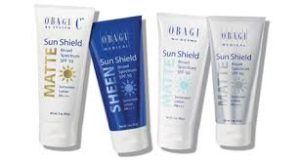Sunscreen Tips
The most powerful anti-aging tool available
The sun’s rays are the number one cause of not only skin cancer, but skin aging. Sun exposure causes 80% of skin aging.
There are three types of rays from the sun that damage your skin:
- UVA rays that age your skin
- UVB rays that burn your skin
- and Infrared Rays that are experienced as heat and penetrate your skin more deeply than UVA or UVB rays. They cause the most severe skin aging.
You can get sunburned year-round and even on cloudy days because UVA rays are always present. UVA rays can penetrate windows and you DO experience sun damage in your car. This is why the left (or driver’s side) side of your face is oftentimes more damaged or wrinkled than the right side.
The number one thing you can do to prevent sun damage is to avoid the sun, wear protective clothing, and always have a hat handy.
What to look for in a Sunscreen?
- SPF: or Sun Protection Factor
- You want an SPF of 30, but much higher than 30 doesn’t mean the sunscreen is substantially better.
BROAD SPECTRUM: (physical + chemical block)
PHYSICAL BLOCK
- Physically blocks/deflects the sun’s rays. Gives sunscreen it’s white color.
- Ingredients: Zinc Oxide (10.5% or more is best) or Titanium Dioxide
CHEMICAL BLOCK
- Breaks down the sun’s rays before they damage skin cells
- Ingredients: example: Octinoxate (there are many)
INFRARED BLOCK (*new):
- Blocks the sun’s Infrared Rays which penetrate the skin most deeply
(ask us about the only sunscreen to block infrared rays, the Supershield by Skin Medica)
ANTIOXIDANTS (*bonus):
- Vitamin C: Neutralizes the free radicals released by sun damage that attack and damage skin cells; prevents skin aging
How Much and How Often to apply sunscreen?
- For Face: 1 tsp.
- For Body: ½ shot glass (1/4 cup)…or more
Even the best sunscreen only lasts 2-4 hours, so reapply often!
*Results may vary from patient to patient

